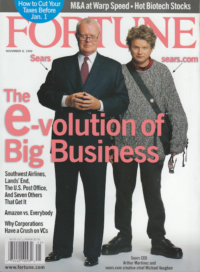In the late ’90s, when the global media conglomerates were at their peak, the people who ran their studios in Hollywood discovered that there was a limit to how much American pop culture the rest of the world would consume. It wasn’t long before they started making movies and TV shows in Mandarin and Hindi.
SEINFELD, MAD ABOUT YOU, JUST SHOOT ME—in recent years, Sony’s Columbia TriStar has produced some of the smartest, hippest sitcoms on television. This year it has high hopes for Chinese Restaurant, a new series about a young Chinese woman in Los Angeles and the multi-culti crowd at her struggling Beijing Garden Restaurant. Of course, the show isn’t really shot in the sprawling Chinese suburbs of L.A., any more than Seinfeld was filmed on the Upper West Side of Manhattan. No, Chinese Restaurant is actually being shot on a soundstage in Beijing by 39-year-old Ying Da—and the actors are speaking Mandarin Chinese. Don’t look for them on NBC either: Chinese Restaurant premiers this fall on 100 television stations across China.
“We thought the Chinese could use a few laughs,” quips William Pfeiffer, the 38-year-old Connecticut native who heads Columbia TriStar’s television operations in Asia.
 What Pfeiffer really thought was that it was time to stop relying on American exports and start tailoring the studio’s offerings to local tastes. This wasn’t part of Hollywood’s plan, of course: The world was supposed to keep consuming Baywatch episodes as eagerly as it does Big Macs and (at least until recently) Cokes. But as the studios morphed into global entertainment conglomerates, with cable and satellite operations and music and publishing interests the world over, they started to discover something no one ever expected: a limit to the appeal of American pop culture—just as the international market became crucial.
What Pfeiffer really thought was that it was time to stop relying on American exports and start tailoring the studio’s offerings to local tastes. This wasn’t part of Hollywood’s plan, of course: The world was supposed to keep consuming Baywatch episodes as eagerly as it does Big Macs and (at least until recently) Cokes. But as the studios morphed into global entertainment conglomerates, with cable and satellite operations and music and publishing interests the world over, they started to discover something no one ever expected: a limit to the appeal of American pop culture—just as the international market became crucial.
In the 1970s, recalls Pfeiffer’s boss, Sony Pictures Entertainment Chairman John Calley, “you got 30% of your income from international. Now it’s almost the reverse.” Not coincidentally, Sony last year became the first global company to go into foreign-language film production, when Columbia TriStar set up shop in Germany at Babelsberg, the long-dormant Potsdam studio where Fritz Lang shot Metropolis. Sony execs figure English-language pictures still command nearly 80% of the world’s box office—but for how long? “When you’ve got that kind of market share,” worries Columbia TriStar film chief Ken Lemberger, “you can only go down.”
In television, that’s happening already: For two years running, the big news at MIPCOM, the global television sales fest at Cannes, has been American series being pushed out of prime time by the local stuff. Network hits like E.R. are still big, but the fledgling satellite and cable companies that bought American shows wholesale a few years ago, outfits like Canal Plus in France, are now billion-dollar enterprises with the resources to fill their evenings with local programming. “As the European marketplace continues to mature, you won’t find a lot of American series in prime time,” says Andy Kaplan of Columbia TriStar Television.
A Decade of Reporting on the Global Media Conglomerates |
In the 1990s and into the 2000s, a series of ego-fueled mega-mergers led to the creation of six global media conglomerates: News Corp., Sony, AOL Time Warner, Vivendi Universal, Viacom and Walt Disney. For most, it would not end well. |
Can the PS3 Save Sony?The company that created the transistor radio and the Walkman is at the precipice.
|
Barry Diller Has No Vision for the Future of the InternetThat’s why the no-nonsense honcho of Home Shopping Network and Universal is poised to rule the interactive world.
|
The Civil War Inside SonySony Music wants to entertain you. Sony Electronics wants to equip you. Too bad their interests are diametrically opposed.
|
Big Media or BustAs consolidation sweeps the content and telecom industries, FCC Chairman Michael Powell has a plan: Let’s roll.
|
Vivendi’s High Wireless ActWill a global media company with continent-wide mobile distribution prove unbeatable?
|
Reminder to Steve Case: Confiscate the Long KnivesTime Warner brings fat pipe and petabytes of content to AOL—plus a long history of infighting and backstabbing.
|
TV or Not TVRupert Murdoch aims to capture Europe’s interactive TV market with a Sun set-top strategy. But a growing Microsoft alliance has different plans.
|
Think Globally, Script LocallyAmerican pop culture was going to conquer the world — but now local content is becoming king.
|
Edgar Bronfman Actually Has a Strategy—with a TwistThe Seagram heir is challenging Disney in theme parks and spending billions to be No. 1 in music. Can this work?
|
There’s No Business Like Show BusinessA handful of powerful CEOs are battling for the hearts, minds, and eyeballs of the world’s six billion people.
|
What Ever Happened to Michael Ovitz?Striving to make his comeback, CAA’s superagent is now an unemployment statistic. Seven lessons to be learned from the fall of the image king.
|
Can Disney Tame 42nd Street?Disney is pouring millions into one of Manhattan’s most crime-ridden blocks. What does Michael Eisner know that you don’t?
|
Twilight of the Last MogulLew Wasserman has been shaking Hollywood since the ’30s. When Seagram bought MCA, was he really out of the loop, or was he king of the dealmakers to the last?Los Angeles Times Magazine | May 21, 1995 |

 November 8, 1999
November 8, 1999




